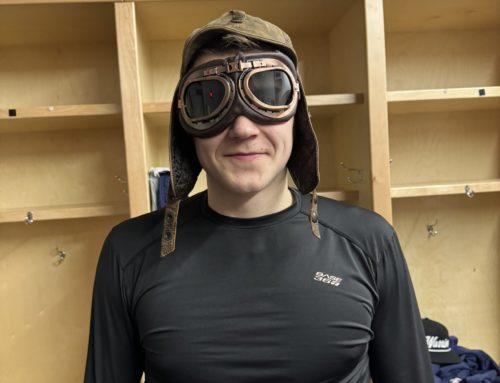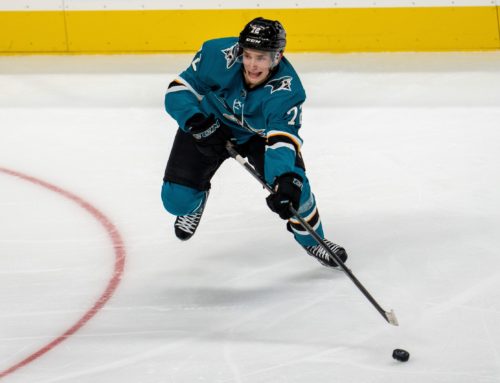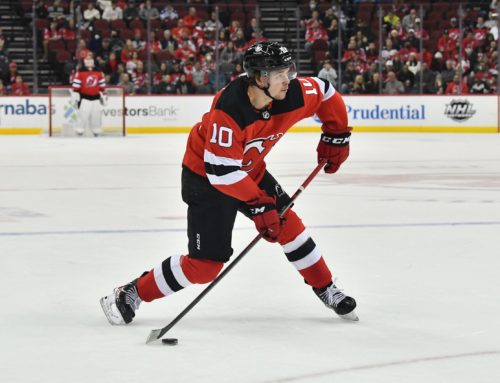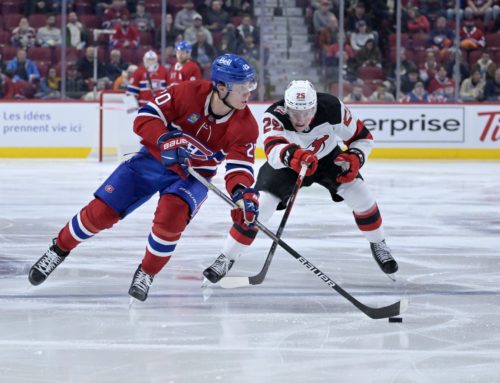The Century Mark: Krebs, Boldy, Moser
Alex Wyatt
2023-01-26
Cover Image: Hockey Wilderness
Every month, Alex Wyatt digs into some players who have reached the 100 NHL games played threshold, as this is the mark, or near it, that many leagues use as their threshold for players casting off their minors eligibility.
Peyton Krebs (BUF, C, 22 years old)
My, the Buffalo Sabres are exciting this season aren’t they? Tage Thompson has gone nuclear, Jeff Skinner has remembered how to put pucks in the net, Alex Tuch has fit in well and is growing into his frame—though his 400-game Breakout Threshold is still quite far down the road given his Band-Aid Boy certification. Oh, and Peyton Krebs has played 37 games this season too.
He has not been a big part of the Sabres’ renaissance, and given that a number of players who were floundering in years past have found their feet and have taken off, the ability to carve out a top-six spot for himself has gotten that much more difficult.
This doesn’t mean it’s game over for Krebs. He is freshly 22 and has only played 98 games in his young NHL career. The problem is that many keeper leagues use the 100 NHL games played mark, or close to it, as a threshold where players cannot be held or kept on the farm and must be called up or set free. I find myself in such a dilemma with Krebs in one of my leagues right now.
Besides his youth, Krebs has consistency going for him. His production is not that much different than last year, which we will dig into, but the fact that we have not seen growth makes it hard to reserve a roster spot for a young fella who was traded last year and has not factored in a great deal to the growing team around him.
Deployment can hinder development and fantasy relevance. Across his 98 NHL games, Krebs is slightly under his career 29-point pace (27 this season), bang on his shot per game average, and a touch above his hit per game average. Consistent, yes, but at worst, possibly stagnated. Helping that stagnation is the far right side of the table, Time On Ice. He has lost a minute and a half of power play ice time vs last year, and is being fed 13% of the available power play time compared to 45% last year. His overall time on ice is down two minutes this year as well. His linemates have not changed a great deal in terms of quality, but he no longer sees time with the improving Dylan Cozens, and instead seems sewn to the shoulders of Kyle Okposo and Zemgus Girgensons.
We can see his usage below and get some positive news again. Relative to his forward peers on the Sabres, he is driving play well with a positive Corsi and is getting a sliver more offensive deployment than other young players like Cozens and Quinn. He is also playing against a slightly stronger quality of competition than some of his peers. His limited ice time is reflected in his relatively small bubble. Not shown here is Krebs’ strong IPP: he has factored in on 66% of the goals scored while he is on the ice.
When Krebs was drafted 17th overall in 2019, folks wondered if maybe he was a steal, given that he suffered a partial tear of his achilles in his draft year as a result of a skate cut, which limited his opportunity to play and build his draft stock.
He consistently exceeded a point per game in the WHL, which one expects of forward prospects of note, but where hopes were heightened was his transition to the professional ranks. With the COVID pandemic throwing wrenches in all aspects of life, young players found themselves playing in different leagues and moving around more than would be appreciated in a recently drafted NHLer’s mind as he tries to develop and prove his worth.
Krebs did great in 2020-2021 with five points in five AHL games, eight points in seven WJC games, and 43 in 24 WHL games all in one year. His 15 points in 18 AHL games the following year were a welcoming sign, and he’s been up in the NHL ever since.
You can see this steady progression reflected in the NHLe charts in the Hockey Prospecting model, but Krebs’ star power has seemingly dwindled since his draft year. To his credit, his NHLer probability grew each year. I think these two graphs model the general perspective on Kreb’s fantasy value as well. The shine has muted over his time in the NHL but he’s been just fine in general. Keep in mind that he is a young pro still acclimating to the NHL—first with a new team in flux (VGK), then traded to a team (BUF) that had its own issues at the time.
So what do we do with Krebs as fantasy managers? I think it is contextual. If you are a contending team hoping to make a run for a cup, Krebs will not help you do that. You would be better holding the space for streamers to tilt your matchups, and I would look to trade him. The hard part is that he has not helped his value so far but he may very well pop and make you regret it. If you are a rebuilding team, you have a decent buy low opportunity with Krebs right now, but factor in the roster make up rules in your league. Based on depth and settings, does Krebs sit above any of your current keepers? I think Krebs will be just fine as an NHLer, but if we have to decide what to do at the Century Mark for him and can’t kick the can down the road any longer, I can’t make a compelling case that he is more than a replacement-level producer at this point. Do you have the room or patience to wait and see if he pays off in the future? Keep him if you can afford the space, but he’s a tough keep to carry into the offseason.
Matthew Boldy (MIN, LW, 24)
Oh what a refreshing feeling, isn’t it fellow Boldy holders? Picking up a highly touted player, likely near the end of the first round/beginning of the second round in a twelve-team league, watching him progress through the ranks, and having him pay immediate dividends as a rookie, and follow it up in his sophomore season—it’s poetry.
Oftentimes when picking in the top three, anything short of immediate help or dominance of a league below the NHL is a disappointment. Later picks are always exciting when they land, but it’s those middle ones that always feel most fraught with risk.
Boldy rewarded your faith in investing your draft capital in him by breaking the point-per-game mark in his final NCAA campaign (11 goals, 20 assists in 22 games) and doing it again in the AHL (six goals, 12 assists in 14 games). He hit the point-per-game mark again the next year in the AHL (10GP, 4G and 6A) before being called up to the big club, where he nearly did it again. He scored a balanced 12 goals and 17 assists in 47 games with Minnesota.
He is a little cooler this year but appears to have avoided the sophomore jinx and has earned a seven-year, $7m AAV contract extension as a result. Minnesota has locked down a young top-six winger for the better part of a decade. Given the makeup of their roster, poolies should see Boldy as an even better option now given his certainty and opportunity.
In his first NHL season, Boldy paced for 68 points, put up nearly 2.5 shots per game, and just under half a hit per game. He did so skating 15 minutes a night, mostly with Kevin Fiala and Frederick Gaudreau, winning the Goals Scored share by a wide margin (+15) and Corsi For share (51.4%) while on the ice, and getting just under half the power play minutes (46.6%) available.
This year, his ice time is up nearly two and a half minutes and his powerplay share has increased to 75%, so he actually is getting better deployment. His shots per game are up from two and a half to three over last season, and hits are up from half a hit per game to just under one, likely as a result of his extra ice time. His 82 game point pace has dipped a touch from last year, from 68 to 56, but there’s nothing of concern here. His entire NHL career spans ten games more than an entire season. These are the ebbs and flows one can expect, especially from a youngster over 92 games.
Compared to his peers who play forward for Minnesota, he is being sheltered in terms of the quality of competition he faces, but the puck drops in the offensive zone for Boldy less often than it does for several of his team mates. Despite getting a little less-choice offensive opportunity, he is making do with the time given, ranking pretty much in the top six for Shot Attempts For vs Against. It won’t be long until his bubble slides further to the right.
Now, how about the luck? How about the consistency?
I like what I see here. His PDO is actually a bit lower than last year, and less than 1.000, implying that the puck is bouncing a little less favourably this year than last. Offensive zone starts are similar to last year and mentioned above. He is shooting more, getting far more deployment as mentioned above, and his assists are mostly primary, meaning he is the one who passes the puck to the eventual scorer, implying he is the straw stirring the drink more often than he is a passenger in goal creation. His IPP—the percentage of goals scored while he is on the ice that he factors in on—has slid a touch and is not quite elite yet. But he is young and has been playing without a Kevin Fiala-level linemate this year.
If you don’t already use Hockey Prospecting, may I suggest it again, and if you do, you might have sorted the 2019 draft by Draft Year star probability and noticed Boldy sitting 8th overall in that measure, but the second best winger to bet on. No offense to Mr. Dorofeyev, but Byron has said the MHL/VHL are tough to draw comparisons from, and he wasn’t really viewed as a top ten selection at the time.
Since the draft, he has grown that 47% chance of becoming a star (0.7 point per game career pace) and sits behind only Jack Hughes and Trevor Zegras from that draft for the top spot.
Based on everything we can look at right now, Boldy is a keeper through and through. I think we will see him continue his fantastic trajectory to become a mainstay in Minnesota’s top six, featuring on their top line and powerplay. Boldy looks promising. If you can possibly use his drop in point pace this year as a seed of doubt to create some space between Boldy and the manager that holds him in your league, then you’d be wise to do so.
J.J Moser (ARI, D, 22)
Janis Jerome Moser was not a name I had heard until a manager in one of my leagues started dropping his name in the chat. This guy often pumps the tires of recent pick ups, so I scoffed and paid it no mind. But gradually over the months that followed, Moser has rounded into precisely the type of defensemen I like to keep my eye on. You snooze, you lose, as they say.
Everyone knows there are a limited number of Powerplay Quarterbacks in the league, and the best ones are cornerstones of championship teams, both in fantasy hockey and NHL hockey. The equally valuable—though slightly less sought after in fantasy hockey—defensemen are the ones who might slide down lists based on scoring totals but fill many other categories reliably. Depending on your league settings, it may be less valuable to pair Quinn Hughes with Radko Gudas, so that Gudas’ 200 hits and 100 blocks but five goals and eight assists are tempered by Hughes’ 15 goals and 65 assists but only five hits.
So where does Moser fit into this equation?
Over his 90 NHL game sample size—43 games last year and 47 this year—he has been remarkably consistent on the consistently-bad-though-improving Arizona Coyotes. He is currently mired in the midst of an eleven-game pointless streak, which has softened what would have looked like a step forward for him production-wise. As with Boldy, Moser’s entire career spans eight games more than a full season, so some slack is warranted.
Given that both of Moser’s seasons so far are nearly identical in games played, you can see consistent patterns emerge. His offensive production is nearly identical, with a 31-point pace this year, an awful plus-minus one would expect of a young defensemen playing 20 minutes a night for the Coyotes, and a consistently tidy 10% shooting percentage. What has been sneaking up for Moser, however, is his utilization. His 20:30 minutes a night in ice time and two and a half minutes on the powerplay represent a a step forward since last year. He has gone from 28% of available PP time to 46% this year—still getting less than half of the available minutes, which currently belong to Shayne Gostisbehere, and half of the available shorthanded time.
Equal usage on the powerplay and penalty kill shows that Moser is trusted both to provide offense when his team has the extra man, and prevent it when they are down one. This type of deployment will lower his offensive opportunity—at least until Arizona trades one or both of Gostisbehere and Chychrun—but likely help his hits and blocks totals by playing primarily in the defensive end. He averages half a penalty minute, just under a hit, just over a shot and a block and a half a game, which is very nice category coverage if your league measures all of them.
As we see above, he gets the least offensive zone starts, which go to the aforementioned Chychrun and Gostisbehere, who are doing well with it. Moser has a larger circle (more ice time) than the remainder of his peers, and it is orange (negative relative Corsi) but lighter than all but Juuso Valimaki (better performance). Kudos to you if you noticed Dyson Mayo way down in the bottom left. Moser’s light orange circle is also high up (playing against relatively tougher competition), meaning he is not being sheltered as he grows, while Gostisbehere and Chychrun are lower. Once one of those two is almost inevitably traded for assets, as Arizona seems to do every year, he is one of the best remaining options to fill in those minutes, with perhaps a slight edge to Valimaki.
The opportunity and ice time for Moser should grow after the deadline.
Even with that potential opportunity for growth, it is important to take note of his pedigree. Hockey Prospecting does not project him as the type of guy to become a star and average 37 points a year over his career. At 22 years old and 90 games played, Moser is already averaging 30 points a season. He also has a history of decent production: two years ago, he finished seventh in scoring among defencemen in the Swiss National League. There is a dearth of players drafted by NHL squads in that league, which likely skews HP’s data in terms of projecting future outcomes when comparing to historical ones. Moser was not a stand out offensive performer in the NL though, so it is fair to presume he will not be in the NHL either.
I am torn on Moser. In a few of my leagues where blocks aren’t counted and the categories lean towards rewarding offensive performance, Moser does not rate at all. But in more balanced leagues with upwards of 20 teams, he becomes a very intriguing option. It is even more advantageous to consider him in a cap league, where he has one more year of his entry level contract still in place.
I would imagine you could scoop Moser in most leagues, and you can bank on his production edging up slightly if he gets more deployment in the event of Arizona shipping out a defenceman. Let your league settings be the deciding factor whether he is worth your time. If your league rewards balanced production, or your team could use a reliable category filler, Moser could end up being a decent, cheap addition to round out your squad.
Thanks for reading, and see you next month.






